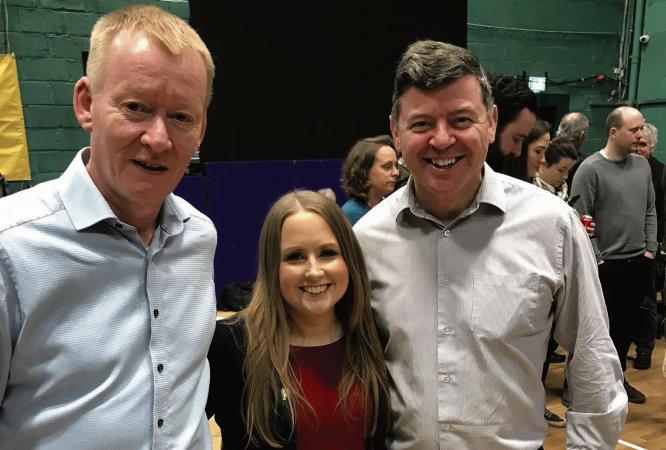Political World
Government set to face its greatest test in tackling the mortgage crisis

Political World with Harry McGee – harrymcgee@gmail.com
Some years ago, the UCD economist Morgan Kelly – the man who foresaw the crash of the property boom – made a new prediction. He said that the next big crisis would be caused by mortgage defaults.
He may have overstated the extent of the implications of it – he wrote about almost a full-blown peasants’ revolt – but he was not too far off the money. And unlike his earlier warnings, he wasn’t alone this time.
But there were still doubters who just couldn’t get their head around it that the malaise would spread to Irish homeowners who had a reputation for sacrificing everything just to make sure the mortgage repayments were made.
Just a cursory look at the mortgage arrears statistics confirms the extent of the problem. At the end of 2010, some 44,508 mortgage accounts were in arrears for 90 days or more, in other words problem mortgages. That constituted 5.7 per cent of the total.
Two years later, that figure had more than doubled to 94,500 private dwellings being 90 days or more in arrears. That’s well over ten per cent. What is worrying is that 23,500 of those have been in arrears for over 720 days – that’s two years. Many of those mortgages are essentially beyond recovery.
It’s one of the tortuous realities now coming home to roost as everything deflates after the boom years. Over the past few weeks I have spent a lot of time on the hustings in Meath East for its bye-election.
What’s remarkable about the county is that the biggest towns in the this three-seat constituency from 30 years ago have been dwarfed by small villages in the south of the county that have been transmogrified into big dormitory towns for Dublin.
Ashbourne now has a population of 10,000, while other towns like Dunboyne, Dunshaughlin and Ratoath have also grown into behemoths.
It has made for a kind of hybrid constituency. The south is commuterland, with people living in houses and flats on new estates and developments built during the boom. The north has its fair share of long-distance commuters but it is more rural and more traditional.
You go to country areas of Kells and Nobber and Skryne and you find a much stronger Fine Gael and Fianna Fáil mix than in the south where things are more volatile and shifting.
In the commuter areas, you find droves of people in negative equity, living in starter homes and flats that are unsuitable for their growing families. But they can’t move because they are trapped by negative equity. And then there’s the mix on the same estate.
Those who worked in anything that touched of construction and development during the boom and who are now unemployed and struggling with their repayments.
And then there are the legions of public sector workers (there are a lot of guards, health sector workers, civil servants) who are incandescent with fury over what they consider to be unfair cuts.
I was in the supermarket in Ratoath on Monday to see the extraordinary exchange between an off-duty Garda and Taoiseach Enda Kenny, where the guard railed about the loss of overtime payments.
For more, read this week’s Connacht Tribune.

Connacht Tribune
The fine art of good timing when it comes to elections

World of Politics with Harry McGee
Academically, politics is described as a science. But in the real world, it’s more of an art – and one of the big decisions a Government has to make is to decide when to call an election.
Will they see out the full term, or will they go early – either to mitigate the damage they will ship, or to secure a victory before things go awry, or the economy takes a dip, or some kind of controversy erupts?
Timing is everything.
And there’s a bit of art to that – not to mention a lot of luck. If you call it early and win big, you’re a genius. If you call it early and lose, you are the political version of the village fool.
Charlie Haughey was a poor judge of the public mood. Twice he called snap elections and on both occasions they backfired. Haughey succeeded Jack Lynch as Taoiseach in late 1979 and did not – technically – have his own mandate. He tried to remedy that by calling an election in 1981. But it recoiled. Ray MacSharry warned him not to hold it during the H Block hunger strikes when republican prisoners were dying each day. He did not listen to the advice and found himself out of office.
After his return to power in 1987, Haughey tired of presiding over a minority government that kept on losing votes in the Oireachtas (the opposition won nine private members motions).
So he called a snap general election and it backfired. Fianna Fáil lost seats and had to broker a coalition deal with the Progressive Democrats and his long-standing political adversary Dessie O’Malley.
For more, read this week’s Connacht Tribune.
Connacht Tribune Digital Edition App
Download the Connacht Tribune Digital Edition App to access to Galway’s best-selling newspaper.
Click HERE to download it for iPhone and iPad from Apple’s App Store, or HERE to get the Android Version from Google Play.
Or purchase the Digital Edition for PC, Mac or Laptop from Pagesuite HERE.
Get the Connacht Tribune Live app
The Connacht Tribune Live app is the home of everything that is happening in Galway City and county. It’s completely FREE and features all the latest news, sport and information on what’s on in your area. Click HERE to download it for iPhone and iPad from Apple’s App Store, or HERE to get the Android Version from Google Play.
Connacht Tribune
Inch protest arguments are more subtle than Oughterard

World of Politics with Harry McGee
I was cycling down Mount Street in Dublin on Tuesday. It’s a wide esplanade that links the Grand Canal with Merrion Square. The street is a mixture of fine Georgian buildings and modern office blocks.
About half-way down is the office of the International Protection Office, which deals with asylum seekers who have arrived in the country.
Needless to say, the office has been overwhelmed in the past year. Besides an estimated 80,000 refugees who have arrived from Ukraine, there have been about 20,000 people from other parts of the world who have arrived into Dublin (mostly) claiming asylum.
The numbers peaked around Christmas, but they have been falling a little. In January, more than 1,300 people arrived seeking asylum but the numbers fell back to 831 and 858, in February and March respectively.
They are still huge numbers in a historical context.
So back to my cycle on Tuesday. I knew that some asylum seekers were camping outside the International Protection Office, but I was taken aback by how many. There were six tents lined up on the pavement directly outside. Then on the ramp that led down to the basement carpark on the side of the building, there were about another 20 tents.
It looked like what it was, a refugee camp in the middle of Dublin’s business district. If you pan out from Mount Street, you will find tents here and there in nearby streets and alleys. There were a good few tents in an alleyway off Sandwith Street about 500 metres away.
For more, read this week’s Connacht Tribune.
Connacht Tribune Digital Edition App
Download the Connacht Tribune Digital Edition App to access to Galway’s best-selling newspaper.
Click HERE to download it for iPhone and iPad from Apple’s App Store, or HERE to get the Android Version from Google Play.
Or purchase the Digital Edition for PC, Mac or Laptop from Pagesuite HERE.
Get the Connacht Tribune Live app
The Connacht Tribune Live app is the home of everything that is happening in Galway City and county. It’s completely FREE and features all the latest news, sport and information on what’s on in your area. Click HERE to download it for iPhone and iPad from Apple’s App Store, or HERE to get the Android Version from Google Play.
Connacht Tribune
Sinn Féin hunt for seats in ‘locals’ across Galway

World of Politics with Harry McGee
God that was a dramatic and historic weekend in England, wasn’t it? So much excitement, so much change, so much hype, so much out with the old and in with the new, and what looks like the coronation of a new leader. Yes, the local elections in Britain were something else weren’t they!
Apologies for not going on about King Charles III but the contract I signed when I became a lifelong republican forbids me to discuss the topic!
I know the British local elections sound a bit boring by comparison, but the results were stunning.
The Conservatives lost nearly 1,000 seats, the British Labour Party gained almost 500 and both the Lib Dems (with 350 gains) and the Greens (gaining over 200) also had amazing days at the polls.
It was Labour’s best day since 2002 but its victory was only partial. The Greens and the Lib Dems actually made gains at the expense of Labour in more affluent areas, and in parts of Britain where there were high numbers of graduates.
It was in the Red Wall constituencies in the North of England where the Labour recovery was strongest. These are working class constituencies with pockets of deprivation where people voted for the Labour Party forever. But all of those constituencies voted for Brexit and then voted for the Tories in the next general election. Labour is now winning back some of those votes.
Local elections are classified as second-tier elections which essentially means – from a national perspective – they are not life-or-death affairs, and not everything turns on them. Of course, it’s really important to have good local representation. But they are not an amazing weather vane for who rules the country.
For more, read this week’s Connacht Tribune.
Connacht Tribune Digital Edition App
Download the Connacht Tribune Digital Edition App to access to Galway’s best-selling newspaper.
Click HERE to download it for iPhone and iPad from Apple’s App Store, or HERE to get the Android Version from Google Play.
Or purchase the Digital Edition for PC, Mac or Laptop from Pagesuite HERE.
Get the Connacht Tribune Live app
The Connacht Tribune Live app is the home of everything that is happening in Galway City and county. It’s completely FREE and features all the latest news, sport and information on what’s on in your area. Click HERE to download it for iPhone and iPad from Apple’s App Store, or HERE to get the Android Version from Google Play.











